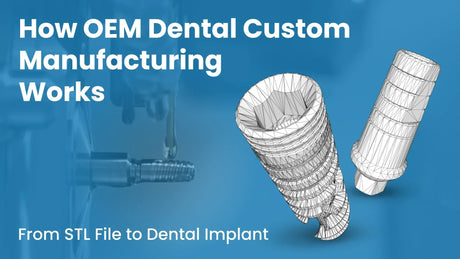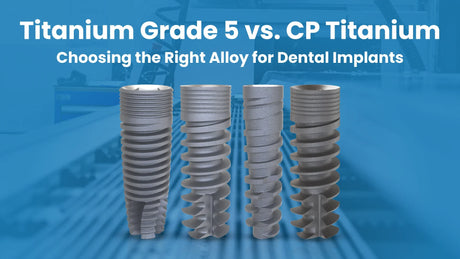

How Healing Abutments Shape Soft Tissue for a Perfect Implant Restoration?
Placing a dental implant is just the first step. What happens next, the way the soft tissue heals around the implant, can make or break the final result. If the gum tissue isn’t shaped properly, even the best-placed implant can end up with an awkward-looking restoration, food traps, or discomfort for the patient.
We’ve all seen cases where the tissue heals too tightly around the implant, making abutment placement difficult. Or worse, where the gums collapse inward, leaving an unesthetic gap between the crown and the soft tissue. These are the kinds of problems that can turn a straightforward implant case into a frustrating one, requiring extra work, adjustments, or even soft tissue recontouring procedures.
This is exactly why healing abutments exist. They’re small, simple components, but they play a huge role in guiding the gums as they heal, ensuring that when it’s time for the final prosthesis, everything is exactly where it should be.
So let’s break it down - how healing abutments work, why they matter, and how choosing the right one can make implant placement and restoration smoother for both the clinician and the patient.
Why Soft Tissue Shaping is So Important
After an implant is placed, the surrounding gum tissue does what it naturally does—it heals. But without a healing abutment in place to guide it, that healing process can be unpredictable. Some areas of the gum may recede too much, while others may overgrow. This can lead to problems when it’s time to place the final abutment and crown.
If the tissue hasn’t been properly shaped, you might be dealing with:
-
A poor emergence profile that makes the restoration look unnatural
-
Tissue overgrowth that needs to be removed before seating the final abutment
-
Excess gaps that create food traps, making hygiene difficult for the patient
-
Deep tissue pockets where bacteria can accumulate, increasing the risk of peri-implantitis
Healing abutments prevent these issues by giving the soft tissue a guide to follow as it heals, shaping the gums into the ideal contour before the final prosthesis is placed.
Step-by-Step: How Healing Abutments Work
Let’s go through the process of using a healing abutment, step by step, and how it shapes the soft tissue for the perfect implant restoration.
Step 1: Placing the Healing Abutment – Setting the Stage for Healing
Once the implant has been placed and integrated with the bone, a healing abutment is screwed into the implant. Unlike a cover screw, which keeps the implant sealed but doesn’t do much else, a healing abutment sits above the gumline, giving the soft tissue a structure to heal around.
It may seem like a small detail, but this step is crucial. Without a healing abutment in place, the soft tissue can heal flat over the implant, making it much harder to place the final abutment later. Instead, the healing abutment creates the proper gingival contour, setting up the implant site for a smooth transition to the final restoration.
Step 2: Soft Tissue Contouring – The Healing Process Begins
Over the next few weeks, the soft tissue gradually adapts to the shape and size of the healing abutment. This is where choosing the right size and shape becomes critical.
-
If the healing abutment is too short, the gum tissue may grow over the implant, making it difficult to place the final abutment.
-
If it’s too wide, it can put unnecessary pressure on the tissue, causing irritation or delayed healing.
The goal is to allow the gums to form a natural, well-contoured emergence profile, similar to how a tooth emerges from the gingiva. This ensures that when the final abutment and crown are placed, they sit flush against the tissue, with no unexpected gaps or irregularities.
Step 3: Removing the Healing Abutment – A Fully Healed Implant Site
After the healing period is complete, the healing abutment is removed, revealing a beautifully contoured, healthy soft tissue profile.
At this point, the implant site is ready for:
-
Taking final impressions or digital scans, capturing the exact shape of the healed tissue
-
Placing the final abutment and crown, without needing to modify or reshape the gums
-
Achieving a seamless transition from healing to restoration, ensuring that the implant looks and functions like a natural tooth
Because the tissue has been guided from the start, there’s no need for extra adjustments or additional healing time - the restoration process can move forward smoothly.
Choosing the Right Healing Abutment – Material, Shape, and Size Matter
Not all healing abutments are created equal. The material, shape, and size you choose can have a direct impact on soft tissue healing and final restoration success.
Titanium vs. PEEK Healing Abutments – Which One to Use?
Titanium Healing Abutments
Titanium has been the go-to material for healing abutments for years, and for good reason:
✔ Biocompatible – Soft tissue heals well around it, with minimal irritation
✔ Strong and durable – Can withstand occlusal forces if necessary
✔ Precisely machined – Ensures a tight, accurate fit with the implant
One downside? Titanium can sometimes cause grayish discoloration of the gum tissue, especially in esthetic areas where the gingiva is thin.
PEEK Healing Abutments
PEEK (Polyether Ether Ketone) is a high-performance polymer that offers some unique benefits:
✔ Tooth-colored material – Reduces the (already small) risk of soft tissue discoloration
✔ Radiolucent – Doesn’t interfere with X-rays, making follow-up imaging easier
For esthetic cases, particularly in the anterior region, PEEK healing abutments are often the better choice.
Stock vs. Custom Healing Abutments – When to Use Each
-
Stock healing abutments - available in standard sizes and are great for most routine cases.
-
Custom healing abutments - designed using CAD CAM technology, match the exact shape of the final restoration, making them ideal for complex cases where precise soft tissue shaping is necessary.
Choosing the right healing abutment ensures predictable tissue adaptation, which makes the final restoration process much smoother.
Healing Abutments Set the Foundation for Long-Term Success
Healing abutments may be temporary, but their impact on implant success is permanent. They guide soft tissue healing, create the right gingival contour, and make sure that when it’s time for the final prosthesis, everything fits and looks just as it should.
At OEMDent, we provide high-quality titanium and PEEK healing abutments, designed to support optimal soft tissue healing and long-term implant stability.
If you want flawless soft tissue adaptation, reduced complications, and a more predictable workflow, choosing the right healing abutment is one of the most effective ways to improve your implant results.
Explore our collection today and take the first step toward perfect implant restorations.

OEMDent.com offers uncompromised quality, cost-effective dental implants & prosthetics compatible with leading implant systems. We go beyond manufacturing, offering OEM & Private Label services to meet your dental needs.






